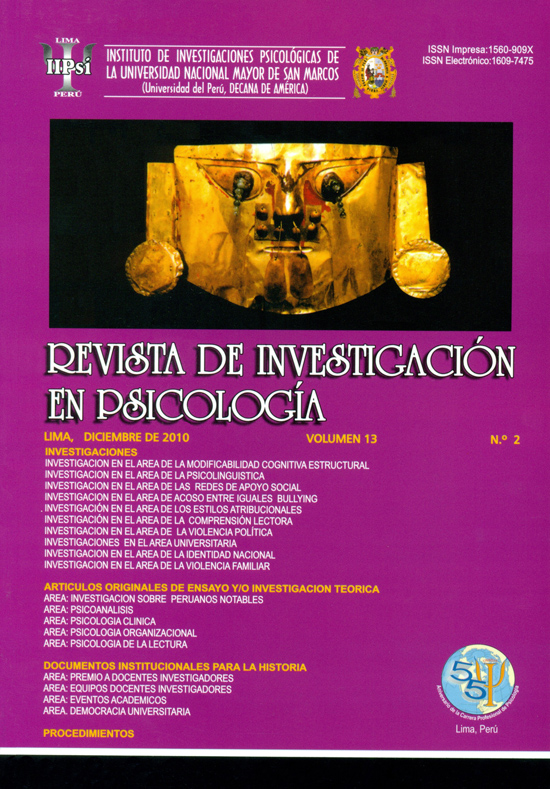Cyberbullying in high school children in Lima Metropolitan
DOI:
https://doi.org/10.15381/rinvp.v13i2.3714Keywords:
cyberbullying, victims, aggressive people, ways of cyberbullying, genreAbstract
Violence among coetaneans acquires new expressions due to the impact of new technologies of information and communication (TICs) in this current generation, these new expressions identify cyberbullying as an intimidating practice used by adolescents with their coetaneans. The objective of this research is to know the prevalence of cyberbullying, establish the differences in genre, school grade and aut.perceived academic performance from the position of the aggressive person or victim, and also the ways which are most used by schoolchildren to intimidate their coetaneans, The sample consisted of 1,703 students from 3rd to 5th high school in public schools in Lima, to collect data, we used the “Cyberbullying questionnaire” (Ortega, Calmaestra y Mora Merchán, 2007) which was adapted by the research team; The results show that the prevalence of cyberbullying is more frequent using the internet than using mobile phones, from the perspective of genre, women are more victimized than men, there are meaningful differences from the position of the aggressive person and victim, this related to the auto-perceived academic performance but not related to the school grade or level; in the different ways of cyberbullying on the internet and on mobile phones, women are more victimized than men, students with regular auto-perceived academic performance are more intimidated and concerning to the school grade, there are differences only in students of 4th and 5th grade in some forms using mobile phones and the internet.Downloads
Published
Issue
Section
License
Copyright (c) 2010 Lupe García Ampudia, Oswaldo Orellana Manrique, Ricardo Pomalaya V., Elisa Yanac Reynoso, Lidia Sotelo L., Noemi Sotelo L., Edgar Herrera F., Hilda Chavez C., Nayú García Z., Dante Macazana F., Daphne Orellana García, Paul Fernandini Q.

This work is licensed under a Creative Commons Attribution-NonCommercial-ShareAlike 4.0 International License.
THE AUTHORS RETAIN THEIR RIGHTS:
a. The authors retain their trademark and patent rights, and also on any process or procedure described in the article.
b. The authors retain the right to share, copy, distribute, execute and publicly communicate the article published in the Journal of Research in Psychology (for example, place it in an institutional repository or publish it in a book), with acknowledgment of its initial publication in the Journal of Research in Psychology.
c. Authors retain the right to make a subsequent publication of their work, to use the article or any part of it (for example: a compilation of their work, lecture notes, thesis, or for a book), provided that they indicate the source. of publication (authors of the work, magazine, volume, number and date).























